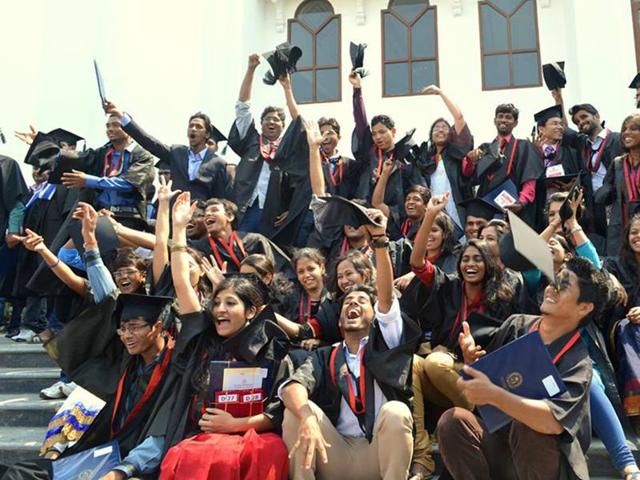Hyderabad varsity to students: Wear ‘angavastram’ for convocation
Since coming to power last year, the BJP-led NDA government has taken several controversial decisions to Indianise education, seen by political parties and activists as an attempt to bring in right-wing ideology into campuses.
The Hyderabad University has banned the traditional black gown during the varsity’s convocation on October 1, a contentious decision derided by some student groups as an attempt to impose a saffron agenda on educational institutions of the country. Since coming to power last year, the BJP-led NDA government has taken several controversial decisions to Indianise education, seen by political parties and activists as an attempt to bring in right-wing ideology into campuses.

In an official e-mail to graduates and alumni recently, the university has suggested an ‘angavastram’ – a traditional Indian shawl -- in place of the gown while prescribing “off white or pale cream kurtha, pyjama/dhoti, saree, or salwar kameez” as the dress code for the ceremony. Sources in the varsity administration said the decision was based on an advisory from the Centre to promote khadi and handloom.
“All universities received a communication from the UGC dated 15 July, 2015 with a request to consider using handloom fabric for ceremonial dresses prescribed for special occasions like convocation. Based on this the university prescribed the dress,” a varsity official said. The university has also pointed out that IIT Guwahati, IIM Ahmedabad and IIIT Hyderabad have already adopted the use of handloom clothes for their convocation.
Two of the student organisations including the Left-wing Students’ Federation of India have (SFI) condemned the move. The SFI said that the varsity’s academic council has rejected its petition against the mandate. “The administration voted against our demand and it will stick to its decision to impose a dress code. SFI is working on possibilities of a protest,” Dayal Paleri, an SFI member said. There were also demands from several quarters to boycott the event.
“Do away with gowns but why enforce Sanghi outfits on students? This is yet another ploy by the government to curtail the freedom of a few remaining free-spirited campuses,” said Hari Krishnan, an alumnus of the university who is currently a PhD scholar at the Jawaharlal Nehru University in Delhi. Vansanglura, a Mizo student pursuing his MA degree in communication, said the prescribed dresses were alien to him.
“If you are from my part of the country, you probably don’t know what an angavastram is,” he said. According to Limakumba Walling, an assistant professor and a PhD scholar, if the government wanted to promote handloom and culture, it should not be in a biased manner. “Every culture and every ethnic wear must be celebrated,” Walling said, adding that even his Naga traditional wear was a handloom product.
However, the right-wing student organisation ABVP welcomed the university’s move calling it “indigenisation and not saffronisation”. “The motive of those opposing it should be questioned. According to the university’s rule, the gown was compulsory for convocation all these years and no one had a problem,” said Harikrishna Varma, an ABVP member and a student of the varsity. However, he agreed that the notification came abruptly and has its drawbacks.
The varsity has 46 different departments and centres organised in 12 schools of study, with over 400 faculties and over 5,000 students. While promoting the handloom sector is at the centre of the controversy, statistics released by the ministry of micro, small & medium enterprises in July show that khadi sales grew by a mere 5.9% (provisional) in 2014-15 compared to 5.8% in 2013-14.
The move came amidst a raging debate over similar sanctions by other educational institutions in the country. Earlier, a Chennai engineering college had imposed various dress and ethics codes for girl students, leading to a furore over the draconian rules. An elite co-educational school in Kerala’s Kottayam district too has asked boys and girls to maintain a safe distance for a “healthy relationship”.











